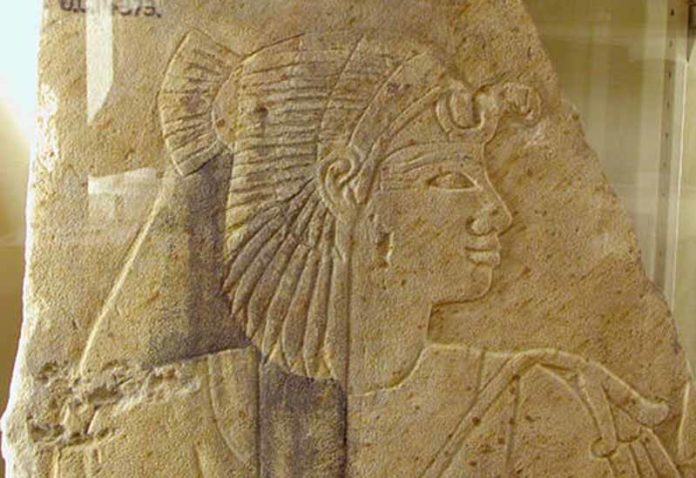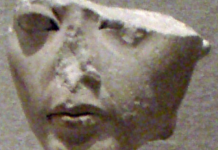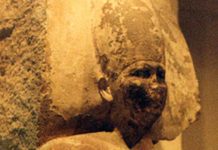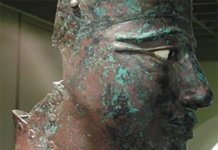Sitamun was the eldest daughter of Amenhotep III and Queen Tiye, and she was elevated to the rank of a Great Royal Wife of the 18th Dynasty and ruled with her parents.
Sitamun had been considered to be a child of Tuthmosis IV – making her a sister of Amenhotep III, but personal items which once belonged to her have been recovered from KV46 – the tomb of Tiye’s parents, Yuya and Thuya- proving that she was in fact Amenhotep and Tiye’s daughter, and she became an Egyptian queen when she reached maturity.
Sitamun’s Early Life at Thebes
She was probably born at the royal palace at Malkata – modern day Thebes, during the 1370’s BC, her name means Daughter of Amun. She was her parent’s oldest daughter which was why she was named so appropriately – being the eldest and most important daughter of the pharaoh. Princes Tuthmosis and Amenhotep (later Akhenaten) were probably born after herself, which may have made her Amenhotep and Tiye’s eldest child.
In her youth Sitamun was given the honorary titles Eldest Daughter of the King, Great Daughter of the King – Whom He Loves, King’s Daughter and King’s Daughter – Whom He Loves, these titles were typical titles bestowed upon the pharaoh’s eldest daughters.
Sitamun was given the honorary rank of Great Royal Wife of her father to coincide with his 30th Jubilee (c. 1357 BC). She received the title King’s Wife, and Singer of the Lord of the Two Lands. It is unknown whether this union was consummated and it is not known if any children resulted, however – the union was most likely to be symbolic in recognition of the relationships of the goddess Hathor being mother, wife and daughter to the sun god.
Royal Women in Egyptian History
Before the reign of Amenhotep III royal wives were never portrayed as prominent as Tiye, royal sons were not depicted in portraits and only daughters were shown, it seems that the importance of the maternal descent was venerated during this period. Cyril Aldred states that this veneration originated during the reign of Queen Ahmose-Nefertari who lived (c.1562 – 1495 BC).
This ancestress of the 18th Dynasty was actively involved in the cult of Amun and could bestow honorary titles to her females descendants – who became Hereditary Princess, and the succession passed through the females. Amenhotep III ascended the throne around the age of twelve and married Tiye in that same year (c.1387 BC), he was the son of Tuthmosis IV and a minor queen named Mutemwiya.
Amenhotep was never expected to rule – because he was a younger son, only on the death of his elder brother, did he become heir apparent. His claim to the throne was somewhat weak, and scholars often ask why he married Tiye who was presumably a commoner, but Tiye was greatly honoured throughout her husband’s reign and she was his chief consort.
Aldred states that Mutemwiya may have been a sister of Tiye’s father – Yuya, and that she contrived the marriage to further her own family’s influence in the land. The Tutankhamun Family Project conducted by Dr. Hawass confirmed that Yuya and Amenhotep were closely related, and it appears that Aldred may indeed have been correct.
Tiye regularly appears with Amenhotep in various forms of artwork, such as inscriptions and on monuments – demonstrating her elevated position in the court. Tiye’s parents, Yuya and Tjuya were powerful nobles under Tuthmosis IV and Amenhotep III – and scholars believe that Tjuya was a descendant of Ahmose-Nefertari herself and that was why Amenhotep was married to Tiye.
The Royal Estate at Malkata
On becoming a Great Royal Wife Sitamun received an impressive estate at Thebes, which was more important that the palaces of any other princesses. Amenhotep appointed the most powerful man in the country – at that time, to govern her estates, he appointed a man named Amenhotep son of Hapu to administrate her palace as her Chief Steward.
At the time she received her new title, there were three Great Royal Wives at the court, Queens Tiye, Mutemwiya and Sitamun. Amenhotep bestowed the title on his mother when he became king, and she lived well on into her son’s reign dying in the latter years of his rule – Amenhotep appeared to be trying to demonstrate three generations of royal women when he promoted Sitamun. After the death of Mutemwiya, he bestowed the same title on two of their other daughters, Isis in Year 34 (c. 1353 BC) and Henuttaneb.
Sitamun’s Death
After the death of Amenhotep III, Sitamun disappears from history and her fate is uncertain, she does not feature during the Amarna period under the rule of her brother Akhenaten and it is likely that she had died – or that she may have retired and lived an obscure existence after her brother assumed the throne. At the time of her father’s death c.1350 BC she was at least twenty years old, and may have even been in her early-to-mid thirties.
The Tomb of Yuya and Tjuya
As Amenhotep III approached the end of his thirty-seven year reign he had two special chambers built into his tomb, one for Tiye and the other for Sitamun, but Tiye was never buried there and there is no evidence that Sitamun was buried there either. To date, the tomb and the mummy of Queen Sitamun have never been discovered.
Within the tomb of Yuya and Tjuya, Sitamun’s portrait appears on the backrests of two chairs, the chairs which are of different sizes must have belonged to her during her youth. In the scene she faces Queen Tiye, who bestows upon her a golden necklace, Sitamun wears a typical Nubian-style wig and above it she bears the crown of lotuses. Inside the tomb twin cartouches bearing her name and that of her father, Pharaoh Amenhotep III were discovered – showing evidence of a father-daughter union, making Sitamun one of the queens of the 18th Dynasty.
Sources:
- Akhenaten by Cyril Aldred, Thames & Hudson Ltd, 1991.
- Tutankhamun by Christine Desroches-Noblecourt, Penguin Books, 1965.








